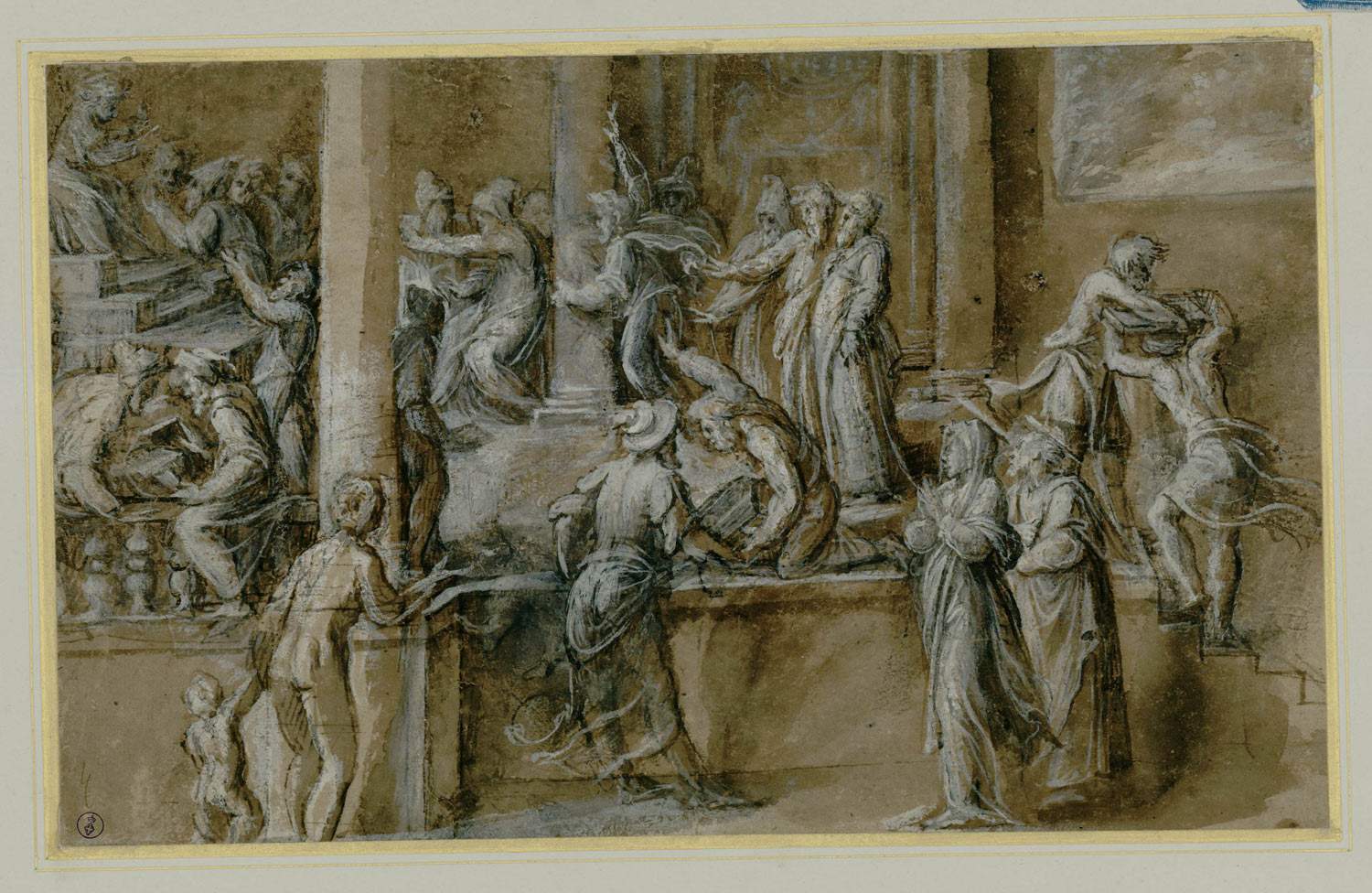Entitled In the Sign of Raphael. Drawings of the Italian Renaissance from the Collections of the Royal Library, the exhibition that, from April 29 to July 17, 2022, at the Royal Library of Turin, will display a precious nucleus of 26 sixteenth-century Italian drawings that can be traced back to Raphael’s circle. The exhibition traces some seventy years of the history of Italian drawing, starting with Perugino, the master from whom the young Raphael Sanzio received his artistic baptism, and passing through the Roman workshop, in which Raphael, at the height of his success, became a pole of attraction and a model of style for an entire generation of artists (Giulio Romano, Parmigianino, Peruzzi, Polidoro da Caravaggio, Baccio Bandinelli, Girolamo da Carpi) who would take different paths from Rome, spreading the lesson of the Urbino master throughout Italy.
The exhibition is the result of a project begun in 2020, on the occasion of the 500th anniversary of Raphael’s death, aimed at the selection, study and cataloguing of Italian drawings traceable to Raphael’s circle owned by the Royal Library. Carried out in partnership with Intesa Sanpaolo - Gallerie d’Italia, the work was entrusted to Angelamaria Aceto, a researcher at the Ashmolean Museum in Oxford, an institute that holds the most important collection of Raphael’s drawings in the world.
Drawings are art forms of particular fascination because they give access to the most intimate dimension of an artist, testify to the creative and formative process of an author, unlike others, are based on the use of few techniques, often a single medium on a small portion of white paper. This essentiality gives them a special expressive power; the drawings reveal the essence of the hand and mind that produced them, but the reading of the message may be less immediate than in other works of art. For this reason, the exhibition presents a rich didactic apparatus, with large panels also containing comparative images with works owned by other museums, to accompany the visitor to discover the articulated world of the Renaissance drawing tradition made up of quotations, copies and studies for other works.
The exhibition is divided into three sections: Perugino and Raphael’s training in Umbria; Raphael’s followers in Rome during the years of papal commissions; and Raphael’s continuators. The first section features drawings by Perugino, the “divin pittore” trained in the prestigious Florentine workshop of Andrea del Verrocchio, frequented at that time by the most promising artists, including Sandro Botticelli and Leonardo da Vinci. Perugino passed on to his pupils the value of drawing practice, the most talented among them being the young Raphael Sanzio of Urbino, who quickly acquired the master’s lesson: the classical and rigorous style, the balance and mathematical study of proportions and perspective, quickly becoming an undisputed model for the artists who would follow him.
The second section, on the other hand, is devoted to Raphael’s followers, young artists who in the years of Pope Leo X arrived in Rome from different cities in Italy and converged in large numbers in the Urbino artist’s workshop, attracted by his charisma and the great success he enjoyed with the most powerful and wealthy patrons. The large number of commissions, combined with his well-known intellectual generosity, led Raphael to delegate much work to his promising pupils, who thus had the opportunity to learn quickly and mature artistically under the master’s guidance. By the time of Raphael’s sudden and untimely death, Giulio Romano was an experienced painter capable of independent production, able to continue many of the prestigious commissions left unfinished by the master. In this period his activity is closely intertwined with that of Polidoro da Caravaggio, Perino del Vaga and Baldassarre Peruzzi, and somewhat lesser known but equally interesting figures such as Vincenzo Tamagni.
Finally, the third section documents the fervent artistic climate of Clement VII’s Rome, which attracted artists from all over Italy to the city. These include the 20-year-old Parmigianino, whose encounter with glorious classical antiquities and with Raphael radically changed his art. In the same years another Emilian, Biagio Pupini, moved to Rome, falling deeply under the influence of Polidoro da Caravaggio, whose expressive graphic language he absorbed. Baccio Bandinelli also turns his gaze to Raphael’s drawings almost as if they were a means to better understand his own personal response to Michelangelo’s expressive visual poetry, as eloquently demonstrated by a little-discussed pen-and-ink drawing in the exhibition. The exhibition concludes with an innovative proposed reconstruction of a sheet made from three fragments, contained in Girolamo da Carpi’s notebook of models, an artifact that in content and form tells us much about Renaissance culture.
The exhibition opens Tuesday through Sunday 10 a.m.-7 p.m., last admission 6 p.m. Closed Mondays. Ticketing at the Royal Museums and directly at the Royal Library - Piazza Castello 191. Purchase online at www.coopculture.it. Tickets: full 10 euros, reduced 18-25 years 2 euros. Combined (admission to exhibition and Royal Museums), € 20.00 full over 25 years, € 4 reduced 18-25 years. Free for under 18; 1 accompanying person for each adult group; 1 accompanying person for non-self-sufficient disabled people; 2 accompanying persons for school groups; journalists with a regular National Order card; ICOM members; Abbonamento Musei holders; Torino + Piemonte Card and Royal Card holders; MiC employees with badges; tour guides with badges.
Image: Biagio Pupini known as Dalle Lame, Christ among the Doctors (c. 1525-1527; brush and ink with brown watercolor and white lead prepared brown paper; Turin, Biblioteca Reale, inv. 15825 AD).
 |
| Drawings from Raphael's circle on display at the Royal Library of Turin |
Warning: the translation into English of the original Italian article was created using automatic tools. We undertake to review all articles, but we do not guarantee the total absence of inaccuracies in the translation due to the program. You can find the original by clicking on the ITA button. If you find any mistake,please contact us.